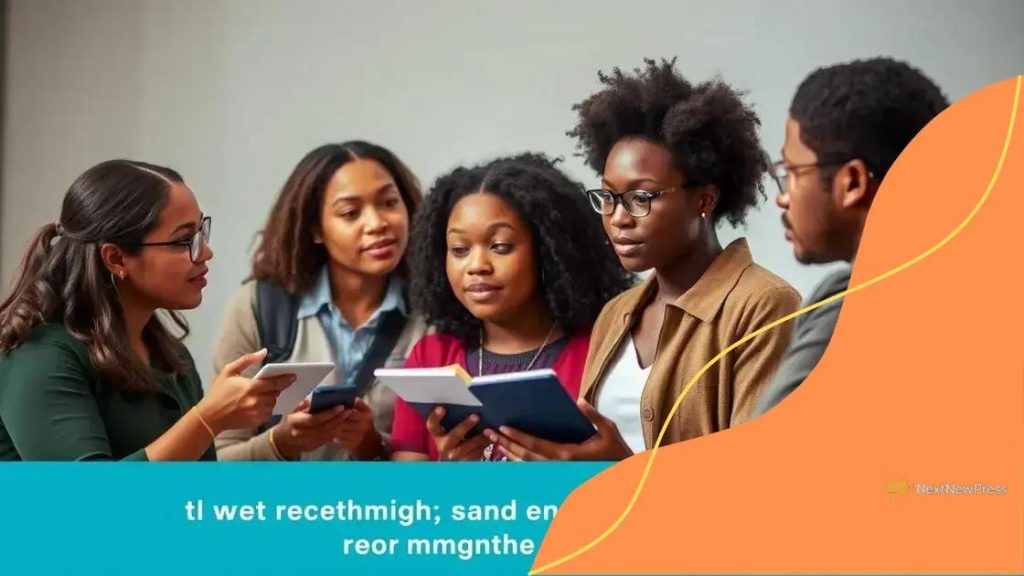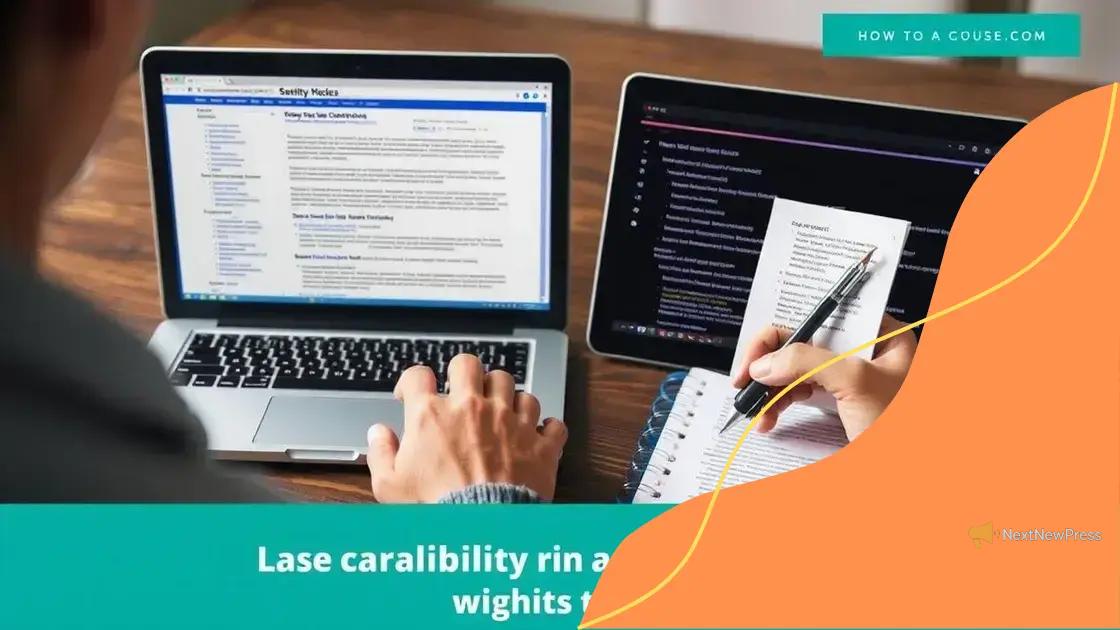Promoting media literacy and critical consumption of information

Promoting media literacy and critical consumption of information equips individuals with essential skills to analyze, evaluate, and create media content, fostering informed decision-making in a digital age.
Promoting media literacy and critical consumption of information is vital in today’s digital age. Have you ever wondered how much misinformation affects our decisions? Let’s dive into this important topic together.
Understanding media literacy
Understanding media literacy is essential in navigating our information-filled world. It helps individuals critically evaluate the content they consume daily. Grasping the basics of this skill can empower people to engage more meaningfully with media.
What is Media Literacy?
Media literacy involves the ability to access, analyze, evaluate, and create media in various forms. It encourages individuals to think critically about the messages they receive. In our digital age, where information is abundant, understanding media literacy is vital.
The Importance of Media Literacy
Being media literate promotes informed decision-making. This skill allows us to discern credible information from dubious sources. Engaging with diverse viewpoints enhances our comprehension and helps us develop our own opinions.
- Encourages critical thinking.
- Reduces the spread of misinformation.
- Fosters responsible media consumption.
Moreover, as technology continues to evolve, so does the media landscape. This change necessitates ongoing education to adapt. As we consume news, social media, and other forms of content, staying informed about media practices is crucial.
A strong foundation in media literacy also cultivates better communication skills. Understanding how to convey information effectively and ethically is essential in both personal and professional contexts. It can enhance collaboration and drive positive interactions.
Key Components of Media Literacy
There are several key components to mastering media literacy:
- Awareness of biases and perspectives
- Understanding the purpose behind media messages
- Ability to recognize advertising and manipulation
By focusing on these aspects, individuals can develop stronger analytical skills. Through practice, they can learn to consume information with an active mindset, questioning its validity and purpose.
In conclusion, understanding media literacy is the first step toward becoming a more informed citizen. It equips us with the necessary tools to critique media content and fosters a culture of thoughtful consumption.
The importance of critical thinking
The importance of critical thinking in today’s world cannot be overstated. It allows us to analyze information effectively and make informed decisions. When we think critically, we do not simply accept everything at face value; instead, we question and evaluate the information presented to us.
Enhancing Decision-Making Skills
Critical thinking enhances our ability to make sound decisions. By evaluating evidence and assessing different perspectives, we can avoid misinformation and bias. This process helps us weigh the pros and cons before reaching a conclusion.
Encouraging Open-Mindedness
Additionally, critical thinking promotes open-mindedness. It encourages us to consider alternative viewpoints and understand various arguments. By doing so, we develop a more rounded perspective, leading to richer conversations and deeper understanding.
- Accept diverse viewpoints.
- Challenge assumptions and beliefs.
- Engage in constructive dialogues.
Moreover, critical thinking fosters independence. As we learn to question information, we strengthen our ability to think for ourselves. This independence is crucial, especially in a society filled with conflicting narratives.
In academic settings, critical thinking is vital for effective learning. Students who practice this skill tend to excel. They engage more actively with their studies and develop a genuine curiosity for knowledge.
Building Problem-Solving Abilities
Another vital aspect of critical thinking is its role in problem-solving. When faced with challenges, a critical thinker can identify the root of an issue and explore various solutions. This skill is applicable in everyday situations, as well as in professional environments.
- Identify and analyze problems.
- Explore creative solutions.
- Evaluate the effectiveness of solutions.
Investing time in developing critical thinking can lead to significant personal growth. As we navigate a complex world, our ability to think critically will empower us to contribute positively to our communities.
Identifying reliable sources

Identifying reliable sources is crucial in today’s information-rich environment. With so much content available, knowing what to trust and what to question can be challenging. Reliable sources provide accurate information, helping individuals make informed decisions.
What Makes a Source Reliable?
A reliable source is typically credible, accurate, and authoritative. First, consider the author’s credentials. Are they an expert in their field? Next, check if the source is well-cited. Reliable sources often reference their information, allowing you to trace the evidence.
Evaluating Online Sources
In the digital age, evaluating online sources is vital. Look for signs of credibility, such as:
- Established reputation of the website.
- Clear authorship with background information.
- Recent updates to ensure the information is current.
Furthermore, be cautious of websites that end in .com, as they may serve specific agendas. In contrast, .edu and .gov sites often provide reliable data.
When researching, cross-reference information across multiple sources to ensure accuracy. This practice helps verify the reliability of the information and strengthens your understanding.
Avoiding Misinformation
To avoid falling prey to misinformation, consider the purpose of the source. Is it trying to inform, persuade, or sell something? Be wary of biases that may distort the truth. Look for balanced presentations that take various viewpoints into account.
- Identify potential biases in the information.
- Consider the intended audience.
- Evaluate the clarity and consistency of the information presented.
Finally, always trust your instincts. If something seems off, it’s worth taking the time to delve deeper. Properly identifying reliable sources will enhance your ability to consume information critically, helping you to make well-informed decisions.
Techniques for effective information consumption
Employing effective techniques for information consumption is essential for navigating today’s complex media landscape. With the vast amount of information available, knowing how to consume it critically can enhance understanding and retention.
Active Reading Strategies
Active reading involves engaging with the text rather than passively skimming through it. Techniques such as highlighting key points, taking notes, and summarizing sections in your own words can help reinforce understanding. This approach encourages deeper processing of the material.
Questioning the Content
Another fundamental technique is to constantly question the content. Ask yourself:
- Who created this information, and why?
- What evidence supports the claims made?
- Are there any biases present?
This strategy promotes critical thinking and helps you evaluate the credibility of the information presented.
Additionally, it’s useful to consider the context in which information is presented. Different contexts can lead to various interpretations, influencing how the content is understood. By being aware of this, you can better analyze the purpose behind the information.
Diverse Sources
Relying on diverse sources is another effective technique. Consuming information from different perspectives enriches understanding. Seek articles, videos, and podcasts from various outlets, including those that may challenge your beliefs. This exposure can provide a well-rounded view of a topic.
- Visit reputable news sites.
- Read peer-reviewed journals.
- Explore educational videos from experts.
Moreover, taking breaks while consuming information can enhance clarity. Allowing time for reflection can prevent information overload. This practice helps process and analyze the data, leading to stronger retention and comprehension.
By using these techniques, you will not only become a more effective consumer of information but will also cultivate a critical mindset, nurturing your ability to discern and evaluate various arguments and claims.
Strategies for promoting media literacy
Strategies for promoting media literacy are essential in today’s information-driven world. Empowering individuals with the skills to critically analyze media can lead to a more informed society.
Educational Programs
Implementing educational programs in schools is one effective strategy. These programs can teach students about identifying reliable sources, understanding media biases, and developing critical thinking skills. By integrating these lessons into the curriculum, students will grow into more discerning consumers of information.
Community Workshops
Community workshops can also play a significant role in fostering media literacy. These events can engage various age groups and backgrounds, providing resources and tools to help individuals navigate the media landscape. Workshops can cover topics such as:
- Understanding misinformation and how it spreads.
- Recognizing the difference between news and opinion pieces.
- Evaluating the credibility of online sources.
Such sessions create opportunities for open discussions, allowing participants to share experiences and strategies.
Online Resources
Utilizing online resources is another practical approach. Many websites and platforms offer free materials on media literacy. These resources can include:
- Interactive quizzes to assess media skills.
- Articles and videos explaining critical concepts.
- Guidelines for identifying fake news.
By promoting these resources, individuals can improve their understanding of media and enhance their consumption habits.
Moreover, encouraging media-related discussions at home can strengthen media literacy. Parents can engage their children in conversations about news articles, social media posts, and advertisements. This practice fosters an environment where critical thinking is valued and promoted.
Lastly, collaboration between media organizations and educational institutions can lead to powerful outreach initiatives. By working together, they can create campaigns that highlight the importance of media literacy in everyday life.
FAQ – Frequently Asked Questions about Media Literacy
What is media literacy?
Media literacy is the ability to access, analyze, evaluate, and create media in different formats. It helps individuals think critically about the information they consume.
Why is critical thinking important in media consumption?
Critical thinking allows individuals to evaluate the credibility of sources and discern between reliable information and misinformation, leading to more informed decisions.
How can schools promote media literacy?
Schools can promote media literacy by integrating lessons on identifying reliable sources and analyzing media critically into their educational programs.
What role do community workshops play in media literacy?
Community workshops provide opportunities for individuals to engage and learn about media literacy in an interactive environment, enhancing their ability to navigate media effectively.





